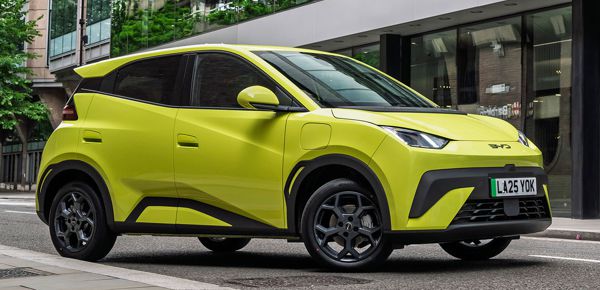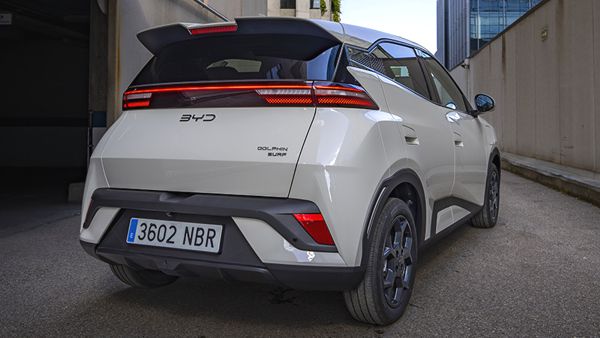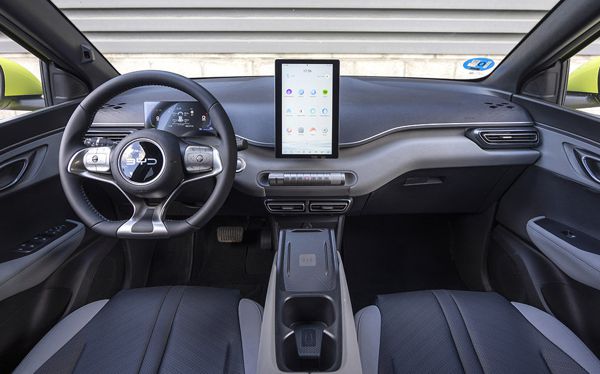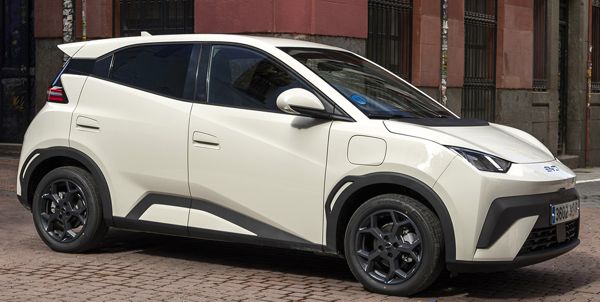Published
on 22
Jul 2025
|
All rights reserved.
|
|

|
|
BYD
sells a B-segment EV at near A-segment price, and it doesn't feel cheap.
|
|
Electric cars can cut
carbon-dioxide emissions over lifetime if they employ
appropriately-sized batteries
and are charged with low-carbon electricity. Western Europe, benefited
from extensive use of renewable energy in electricity generation,
should be a good place to widely adopt electric cars. However, up until
recently the biggest hurdle had been the high prices of electric cars,
which prevents them from penetrating down to the most popular small car
segments. Fortunately, this situation starts changing with the
introduction of really cheap small EVs recently, such as Dacia Spring
(from £15,000), Leapmotor T03 (from £16,000), Fiat Grande
Panda electric (from £21,000), Citroen e-C3 (from £22,000)
and Renault 5 (from £23,000), as they are truly accessible to the
vast majority of motorists. Note that there is a sizable gap between
the first two and the latter three, as the Dacia and Leapmotor are the
smallest A-segment cars with relatively cheap construction and lower
standards of pretty much everything. Conversely, the Stellantis duo and
Renault are normal B-segment superminis with higher standards of
engineering and build quality, especially in the case of Renault, but
you might need to upgrade to more costly models to have your desired
range and features. This gap is where BYD sees a good business
opportunity.
The Seagull is BYD’s smallest and cheapest electric car. It is very
successful since its launch in 2023, registering 480,000 sales
globally last year, although 95 percent of which happened in its home
market. Strictly speaking it is an A-segment car there, measuring just
3.8 meters in length and priced from an incredible CNY57,000, or
equivalent to less than £6000 ! However, for export to Europe, it
is modified with extra crash structures, lengthening to 4 meters.
Better interior finish, higher level of equipment, safety features and
driver assistance systems (some demanded by European regulations) plus
local taxes drive its UK price to just under £19,000, which might
include a sizeable profit margin. This put it to the B-segment
territory, although still undercuts its European rivals comfortably.
Its name needs to be changed, too, as “Seagull” is usually seen as a
kind of birds stealing food from people. While in Latin America it is
called Dolphin Mini instead, the word Mini is in clash with BMW’s small
car brand, so in Europe it is renamed to Dolphin Surf.

|
|
Wolfgang
Egger's design is pretty stylish and original, no longer the copycat we
used to see BYD.
|
|
Despite the very low price, the Seagull / Dolphin Surf is a
well-engineered car. Designed under the leadership of Wolfgang Egger,
it is pretty stylish. It has its own character, too, no longer the kind
of copycat we used to see BYD.
Build quality seems to be way better than its low prices suggested,
actually puts it slightly above Fiat Grande Panda and Citroen e-C3. The
interior is particularly impressive, which includes novel features like
a large (10.1-inch) and rotating center touchscreen. Hard plastics are
everywhere, of course, but at least they are nicely grained to feel not
cheap. The plastic smell of earlier BYD models is banished. Ultimately
it lacks the soft padding, colorful textiles and the classy feel of
Renault 5, but it is not afraid to face any other rivals.
While the rotating feature of that large touchscreen is more like a
gimmick, the infotainment system operated through it is better than
most Chinese EVs offer up until now. Overcrowded functions in the main
screen aside, its operation is largely logical and intuitive, and the
most frequently used audio and climate control adjustment are displayed
permanently at the bottom. Moreover, there is a row of physical buttons
beneath the screen for quicker access to adaptive cruise control and
air-con etc., which is not the case of many EVs today.
The small BYD matches its European B-segment rivals in length and
wheelbase (2500mm), but it is a little narrower at 1720mm. This
reflects in the rear bench, which is strictly for 2 passengers as there
is not even a seatbelt for third. That aside, the cabin is highly
accommodative, as even a 6-foot-2-in person can sit behind himself
without problems. Naturally, the driver seat is positioned higher than
desired due to the placement of battery underfloor, but the car’s very
tall roof ensures plenty of headroom. There are lots of useful storage
space inside the cabin, while the boot is also a good size at 308
liters.

|
|
Build
quality is actually pretty good, accompanied with generous equipment.
|
|
Standard equipment is generous, including sat-nav, Apple CarPlay and
Android Auto, rear parking sensors, reversing camera and adaptive
cruise control on all trims. Range-topping trim Comfort adds wireless
charging, 360-degree camera, heated front seats and rear privacy glass.
However, if you look for only essential features, the BYD’s price
advantage over its rivals diminishes. For that starting price of just
under £19K, you get the base Active model which comes with a
smallish 30kWh battery, even though BYD’s LFP Blade battery is cheaper
to produce. This gives an official WLTP range of only 137 miles, or
practically around 100 miles on the road, which is unacceptable these
days. A DC charge rate of 65kW is okay, accomplishing 10-80 percent in
30min, but the car’s 88-horsepower motor is by no means quick, taking
over 10 seconds to go from rest to 60 mph.
Opt for the bigger battery model strangely named “Boost”, it has the
LFP battery enlarged to a more competitive 43.2kWh, taking range to 200
miles, while charging takes the same 30min due to 85kW speed. Problem
is, its price is lifted to £22K, and it runs even slower than the
base model due to the same motor hauling the heavier battery.
If you want the long range battery and the kind of spirited
acceleration typical to EVs, the range topping Comfort model is the
only option. It keeps the Boost’s larger battery but mates with a 156hp
motor, cutting 0-60 mph to 8.6 seconds – maybe a bit quicker in the
real world. WLTP range drops a little bit to 193 miles, which is
identical to the base Renault 5 with 40kWh battery – the Renault has an
upper hand in energy efficiency, at least as shown in the test cycles.
Unfortunately, the Comfort asks for £24K, a grand more than the
brilliant Renault. Don’t forget the French star is more desirable in
many ways, including a more sophisticated multi-link rear suspension
while the BYD relies on torsion-beam axle. The Renault is slightly
lighter too due to the use of more energy dense NMC battery. For sure
the BYD has room to lower prices further. It should.

|
|
Good
at being an urban car, but pushing beyond it comfort zone will result
in disappointment.
|
|
BYD proudly said it has the world’s first 8-in-1 electric powertrain,
which combines motor, reduction gear, charger, inverter, power
electronics, battery management, vehicle control unit and motor
controller in one. Maybe it has advantages in packaging or production
costs, but in terms of performance or efficiency I don’t see any
benefits from the above figures.
The Seagull / Dolphin Surf is configured in conventional ways – a
skateboard battery platform, front motor and front-wheel drive. Struts
suspension up front, torsion-beam axle at the back to keep costs down.
There is nothing wrong with this layout, as the car drives and goes
very well, especially in urban area where it is designed for. The
Active and Boost models offer just enough performance for everyday use,
while Comfort (again strangely named) offers a brisk turn of speed.
Power delivery is smooth and quiet. The chassis is stiff enough, while
ride and noise insulation are pretty good. It doesn’t crash over bumps
like the smaller Dacia or Leapmotor. Its rolling refinement is decent.
The steering is nicely weighted and geared for easy driving around
town, while a small turning circle makes turning and parking easy in
tight spaces. The only obvious weakness is the brakes, whose pedal
feels mushy and non-linear. It also lacks one-pedal driving mode, and
you need to alter different levels of regenerative braking from the
touchscreen rather than a pedal as some rivals offer.
However, up the pace or slips into a backroad, the car is less amusing.
The suspension lacks adequate damping thus is easily unsettled by
bigger crests and bumps, crashing on potholes and expansion joints. The
steering is light in whatever modes, even in Sport, and it feels numb.
On the 156hp model, the throttle response is slow, lacking an eager
feel the power figure suggested. Maybe BYD deliberately dampened its
throttle response, because you can sense plenty of torque steer and
wheelspin every time you open up throttle. Traction from the 185/55R16
Hankook front tires is unremarkable. In short, the small BYD is good
for urban driving but not on faster or more challenging roads.
For sure, a Renault 5 is a much better car to drive, being more
competent, more engaging yet more comfortable and refined. It has a
better infotainment system, a more attractive cabin and an iconic looks
the BYD struggles to match. Hyundai Inster is probably a better car,
too, but the BYD should be competitive against everything else
currently on offer in Europe. It could be even more competitive if BYD
is willing to sacrifice profit like what it is doing in the
ultra-competitive environment of China.
|
Verdict:    |
|